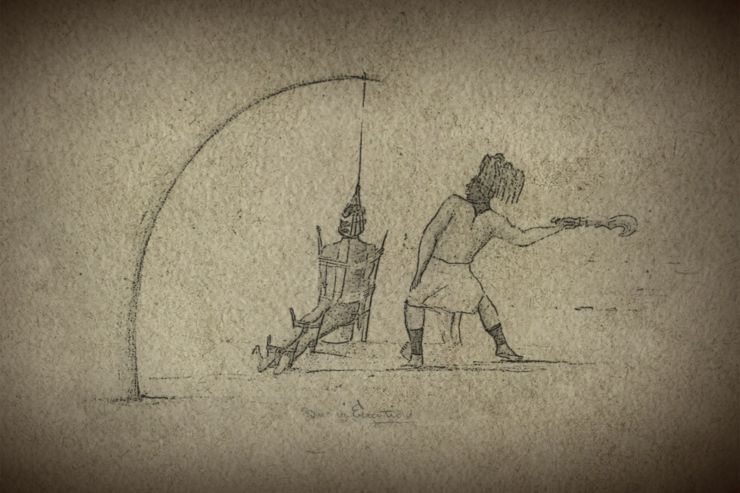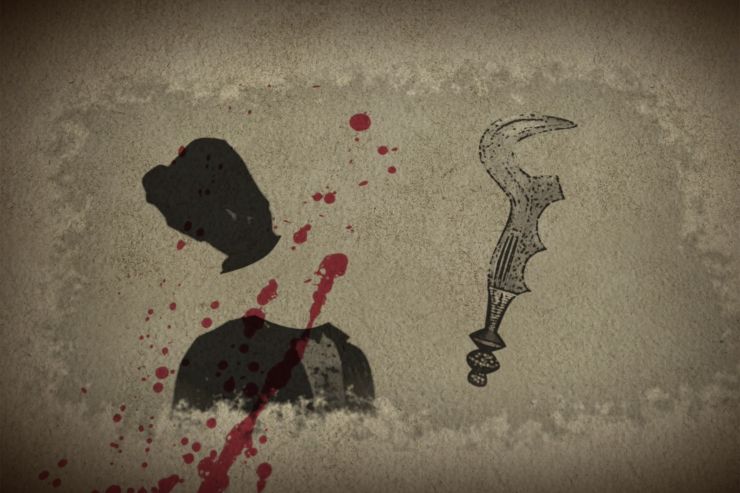Forged in Fire
“Ngombe Ngulu.” S4 Ep12, 17 July 2017, History Channel.
The Ngombe ngulu has a controversial history. Some stories from a century ago describe it being used in the executions of animals and humans, but these stories seem to be more the work of Westerners intent on depicting the savagery of primitive Africa (indeed, the zeitgeist of the early 20th century) rather than telling the whole truth.
An important detail can be found in the exaggeration that describes how these knives were used to decapitate heads and sever limbs. This knife is entirely capable of slitting the throat of a human or an animal, inflicting mortal damage. But decapitating heads and severing limbs is beyond what this knife can do.
I have long tried to assert a more realistic story of the ngulu – that while perhaps it could have been used for executions (by slitting a throat, not by decapitation), it was predominantly used as an insignia of prestige, a ceremonial dance implement, and as a valuable good used for exchange. There is a rich documented history of the ngulu being used in non-lethal settings.
So when the History Channel asked me about the ngulu, I was happy to send a long answer:
As for the function of these knives, the most detailed and reliable resource is "Tribal Art Monographs Vol 1/No. 2." I will email you the entire publication… The reason I say this is the most reliable resource is because of the integrity of the authors. I can point you to a few other books that describe the use of these pieces as execution blades, but those books include a number of errors and exaggerations.
However, these pieces could have been used for actual executions in their original form. The attached pages from "Monographs" include an interesting contradiction: Marc Felix on page 4 describes the far-fetched stories that accompanied these pieces back to Europe. On page 25, Gosseau reprints two such tales along with drawings and photographs. Many scenes depicted in old photographs and postcards were staged for the camera, as cameras were so much less portable then, and also exposures took much longer...
So, what you have here is some evidence to say these knives were used for executions, but no way to know if the evidence is completely true or entirely invented. You have reputable experts believing the executioner story, including Christian Gosseau and, arguably the foremost African knife scholar on the planet, Jan Elsen. Then you have other experts like Marc Felix and myself who believe the executioner tales to be fantasies…
The reason I believe there isn't a lot of stock in the executioner [beheading] tales is that I've held hundreds of these knives, and I don't think they're heavy or sharp enough to do the job, especially if we're killing off groups of slaves at a time and then hacking their limbs off. No way. The second reason I hold my position comes from a detail described on page 19 of Gosseau - the tapering iron blade doesn't even run through the entire wood handle, making the structural integrity of the handle-and-blade pair weaker than almost every other African knife. If used for chopping and hacking in the brutal ways described, the blades would come out of the handles before a limb was severed. Gosseau describes the older pieces used for executions had reinforced handles with braided leather, but again, this would work well to hold the handle on the blade for cutting grass, not for dismembering a group of humans.
Third, one detail about African throwing knives (a separate category from this type) - they were never made with wood handles, because the wood would be more prone to breaking when the knife hit the ground (their handles were made of vegetal fiber, leather, metal wrap, etc.). The amount of violence that would be required for the brutal job described would surely cause the wood handle to break (if the blade didn't first pop out), as the force would far exceed the force experienced if the knife was thrown and hit the ground.
After my strong recommendation and after I sent them the entire document "Tribal Art Monographs Vol 1/No. 2," this was the History Channel’s description the Ngombe Ngulu:
“The Ngombe Ngulu is a ceremonial sword made by the Ngombe tribe of the Democratic Republic of the Congo [TRUE]. Featuring an ornate wooden hilt and an embellished scythe-shaped blade, this intimidating weapon was reputedly used around the late 19th century for the sacrificial beheading of tribal slaves [POSSIBLY TRUE]. The razor sharp [FALSE] outer edge of the hook was said to separate the victims head from his neck in one swift fatal strike [UNFOUNDED]. Following the abolition of human sacrifice, the Ngulu transitioned from executioner’s weapon to an insignia of prestige carried at ceremonial dances [TRUE].


It was a disappointing development to understand that my informed input couldn’t change the History Channel’s narrative, and that stories of savages (ratings) were more important than historical accuracy